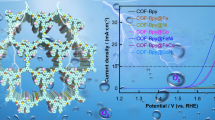Abstract
Hydrogen is considered as one of the most important clean and renewable energy resources to get rid of carbon-based fuels and to solve the problem of environmental hazzards caused for using fossil fuels. Hence, the large-scale production of hydrogen by water splitting through hydrogen evolution reaction (HER) demands inexpensive and efficient electrocatalysts to replace the scarce and expensive noble metal-based catalysts. In this work, using the density functional theory (DFT)-based computations, we have considered a family of one dimensional (1D) metal organic frameworks (MOFs), namely TM–dithiolene (TM–BTT), and TM–bis(iminothiolato) (TM–BIT), consisting of benzene-1,2,4,5-tetrathiolate (BTT) and benzene-bis(iminothiolato) (BIT) organic ligands, respectively, and a family of first row transition metals (TM = Mn, Fe, Co, and Ni), to find their catalytic activity toward HER. Using the Gibbs free energy for the adsorption of atomic hydrogen ( \(\mathrm {\Delta {\textit{G}}_{H^{*}}}\)) as the key descriptor, we reached to the conclusion that Ni–bis(iminothiolato) MOF exhibits better catalytic activity toward HER over all other investigated 1D-MOFs.










Similar content being viewed by others
References
Chu S, Cui Y, Liu N (2017) The path towards sustainable energy. Nat Mater 16:16. https://doi.org/10.1038/nmat4834
Larcher D, Tarascon JM (2015) Towards greener and more sustainable batteries for electrical energy storage. Nat Chem 7:19. https://doi.org/10.1038/nchem.2085
Kamat PV (2008) Quantum dot solar cells semiconductor nanocrystals as light harvesters. J Phys Chem C 112:18737. https://doi.org/10.1021/jp806791s
Sarkar S, Pal S, Sarkar P (2012) Electronic structure and band gap engineering of cdte semiconductor nanowires. J Mater Chem 22:10716. https://doi.org/10.1039/C2JM16810C
Rajbanshi B, Kar M, Sarkar P, Sarkar P (2017) Phosphorene quantum dot-fullerene nanocomposites for solar energy conversion: An unexplored inorganic-organic nanohybrid with novel photovoltaic properties. Chem Phys Lett 685:16. https://doi.org/10.1016/j.cplett.2017.07.033
Sarkar R, Kar M, Habib M, Zhou G, Frauenheim T, Sarkar P, Pal S, Prezhdo OV (2021) Common defects accelerate charge separation and reduce recombination in CNT/molecule composites: atomistic quantum dynamics. J Am Chem Soc 143:6649. https://doi.org/10.1021/jacs.1c02325
Rajbanshi B, Sarkar P (2016) Optimizing the photovoltaic properties of CDTE quantum dot porphyrin nanocomposites: a theoretical study. J Phys Chem C 120:17878. https://doi.org/10.1021/acs.jpcc.6b04662
Das P, Ball B, Sarkar P (2022) Theoretical investigation of a tetrazine based covalent organic framework as a promising anode material for sodium/calcium ion batteries. Phys Chem Chem Phys 24:21729. https://doi.org/10.1039/D2CP02852B
Ball B, Chakravarty C, Sarkar P (2019) Two-dimensional covalent triazine framework as a promising anode material for Li-ion batteries. J Phys Chem C 123:30155. https://doi.org/10.1021/acs.jpcc.9b09268
Ball B, Das P, Sarkar P (2021) Molybdenum atom-mediated salphen-based covalent organic framework as a promising electrocatalyst for the nitrogen reduction reaction: A first principles study. J Phys Chem C 125:26061. https://doi.org/10.1021/acs.jpcc.1c08779
Roy P, Pramanik A, Sarkar P (2021) Graphitic carbon nitride sheet supported single-atom metal free photocatalyst for oxygen reduction reaction: A first-principles analysis. J Phys Chem Lett 12:2788. https://doi.org/10.1021/acs.jpclett.1c00421
Ball B, Chakravarty C, Sarkar P (2020) Silicon and phosphorus Co-doped bipyridine-linked covalent triazine framework as a promising metal-free catalyst for hydrogen evolution reaction: a theoretical investigation. J Phys Chem Lett 11:1542. https://doi.org/10.1021/acs.jpclett.9b03876
Bhunia S, Bhunia K, Patra BC, Das SK, Pradhan D, Bhaumik A, Pradhan A, Bhattacharya S (2018) Efficacious electrochemical oxygen evolution from a novel Co(II) porphyrin/pyrene-based conjugated microporous polymer. ACS Appl Mater Interfaces 11:1520. https://doi.org/10.1021/acsami.8b20142
Sun Y, Xue Z, Liu Q, Jia Y, Li Y, Liu K, Lin Y, Liu M, Li G, Su CY (2021) Modulating electronic structure of metal-organic frameworks by introducing atomically dispersed ru for efficient hydrogen evolution. Nat Commun 12:1. https://doi.org/10.1038/s41467-021-21595-5
Wang J, Fan Y, Qi S, Li W, Zhao M (2020) HER/OER or OER/ORR catalytic activity of two-dimensional \(\rm TM_{3}(HITP)_{2} \) with TM = Fe-Zn. J Phys Chem C 124:9350. https://doi.org/10.1021/acs.jpcc.0c01143
Clough AJ, Yoo JW, Mecklenburg MH, Marinescu SC (2015) Two-dimensional metal organic surfaces for efficient hydrogen evolution from water. J Am Chem Soc 137:118. https://doi.org/10.1021/ja5116937
Song X, Wang J, Qi S, Fan Y, Li W, Zhao M (2019) electrocatalytic activity of bis(iminothiolato) nickel monolayer for overall water splitting. J Phys Chem C 123:25651. https://doi.org/10.1021/acs.jpcc.9b06669
Liu J, Yin H, Liu P, Chen S, Yin S, Wang W, Zhao H, Wang Y (2019) Theoretical understanding of electrocatalytic hydrogen production performance by low-dimensional metal organic frameworks on the basis of resonant charge-transfer mechanisms. J Phys Chem Lett 10:6955. https://doi.org/10.1021/acs.jpclett.9b02729
Zaman N, Noor T, Iqbal N (2021) Recent advances in the metal-organic framework-based electrocatalysts for the hydrogen evolution reaction in water splitting: a review. RSC Adv 11:21904. https://doi.org/10.1039/D1RA02240G
Sun X, Wu KH, Sakamoto R, Kusamoto T, Maeda H, Nishihara H (2017) Conducting \(\pi \)-conjugated bis(iminothiolato) nickel nanosheet. Chem Lett 46:1072. https://doi.org/10.1246/cl.170382
Wang Y, Liu X, Liu J, Al-Mamun M, Wee-Chung Liew A, Yin H, Wen W, Zhong YL, Liu P, Zhao H (2018) Electrolyte effect on electrocatalytic hydrogen evolution performance of one-dimensional cobalt-dithiolene metal-organic frameworks: a theoretical perspective. ACS Appl Energy Mater 1:1688. https://doi.org/10.1021/acsaem.8b00174
Downes CA, Marinescu SC (2015) Efficient electrochemical and photoelectrochemical \(\rm H_{2} \) production from water by a cobalt dithiolene one-dimensional metal-organic surface. J Am Chem Soc 137:13740. https://doi.org/10.1021/jacs.5b07020
Downes CA, Marinescu SC (2016) One dimensional metal dithiolene (M = Ni, Fe, Zn) coordination polymers for the hydrogen evolution reaction. Dalton Trans 45:19311. https://doi.org/10.1039/C6DT03257E
Kresse G, Furthmüller J (1996) Efficiency of ab-initio total energy calculations for metals and semiconductors using a plane-wave basis set. Comput Mater Sci 6:15. https://doi.org/10.1016/0927-0256(96)00008-0
Kresse G, Furthmüller J (1996) Efficient iterative schemes for ab initio total-energy calculations using a plane-wave basis set. Phys Rev B 54:11169. https://doi.org/10.1103/PhysRevB.54.11169
Blöchl PE (1994) Projector augmented-wave method. Phys Rev B 50:17953. https://doi.org/10.1103/PhysRevB.50.17953
Perdew JP, Burke K, Ernzerhof M (1996) Generalized gradient approximation made simple. Phys Rev Lett 77:3865. https://doi.org/10.1103/PhysRevLett.77.3865
Monkhorst HJ, Pack JD (1976) Special points for Brillouin-zone integrations. Phys Rev B 13:5188. https://doi.org/10.1103/PhysRevB.13.5188
Gao G, O’Mullane AP, Du A (2017) 2D mxenes: a new family of promising catalysts for the hydrogen evolution reaction. ACS Catal 7:494. https://doi.org/10.1021/acscatal.6b02754
Chakravarty C, Mandal B, Sarkar P (2019) Bis(iminothiolato)-based one-dimensional metal organic framework: robust bipolar magnetic semiconductor with reversal of spin polarization. J Phys Chem C 124:37. https://doi.org/10.1021/acs.jpcc.9b08456
Ray K, Begum A, Weyhermüller T, Piligkos S, Van Slageren J, Neese F, Wieghardt K (2005) The electronic structure of the isoelectronic, square planar complexes \([Fe^{II}(L)_{2}]^{2-}\) and \([Co^{III}(L^{Bu})_{2}]^{-}\)\((L^{2-} \rm and (L^{Bu})^{2-} = \rm {benzene-1, 2-dithiolates})\): An experimental and density functional theoretical study. J Am Chem Soc 127:4403. https://doi.org/10.1021/ja042803i
Luiz Benedito F, Petrenko T, Bill E, Weyhermuller T, Wieghardt K (2009) Square planar bis \(\{\)3, 6-bis (trimethylsilyl) benzene-1, 2-dithiolato\(\}\) metal complexes of \(\rm Cr, Co^{III}\) and Rh: an experimental and density functional theoretical study. Inorg Chem 48:10913. https://doi.org/10.1021/ic9008976
Gao D, Xia B, Zhu C, Du Y, Xi P, Xue D, Ding J, Wang J (2018) Activation of the MoSe2 basal plane and Se-edge by B doping for enhanced hydrogen evolution. J Mater Chem A 6:510. https://doi.org/10.1039/C7TA09982G
Liu H, Long W, Song W, Liu J, Wang F (2017) Tuning the electronic bandgap: an efficient way to improve the electrocatalytic activity of carbon-supported \(\rm Co_{3}O_{4} \) nanocrystals for oxygen reduction reactions. Chem A Eur J 23:2599. https://doi.org/10.1002/chem.201604528
Feng W, Pang W, Xu Y, Guo A, Gao X, Qiu X, Chen W (2020) Transition metal selenides for electrocatalytic hydrogen evolution reaction. ChemElectroChem 7:31. https://doi.org/10.1002/celc.201901623
Deng S, Yang F, Zhang Q, Zhong Y, Zeng Y, Lin S, Wang X, Lu X, Wang CZ, Gu L et al (2018) Phase modulation of \((1T--2H)-\rm {MoSe}_{2}/\rm TiC-C \) shell/core arrays via nitrogen doping for highly efficient hydrogen evolution reaction. Adv Mater 30:1802223. https://doi.org/10.1002/adma.201802223
Grimme S, Antony J, Ehrlich S, Krieg S (2010) A consistent and accurate ab initio parametrization of density functional dispersion correction (DFT-D) for the 94 elements H-Pu. J Chem Phys 132:154104. https://doi.org/10.1063/1.3382344
Grimme S, Ehrlich S, Goerigk L (2011) Effect of the damping function in dispersion corrected density functional theory. J Comput Chem 32:1456. https://doi.org/10.1002/jcc.21759
Momma K, Izumi F (2008) VESTA: a three-dimensional visualization system for electronic and structural analysis. J Appl Cryst 41:653. https://doi.org/10.1107/S0021889808012016
Acknowledgments
The authors sincerely acknowledge the Council of Scientific and Industrial Research (CSIR) [Sanction No. 01(3086)/21/EMR-II], India for financial support of this work. P.D. thanks the DST-INSPIRE, New Delhi, Govt. of India for the award of INSPIRE fellowship (No. DST/INSPIRE Fellowship/[IF200050]).
Author information
Authors and Affiliations
Contributions
PD, BB, and BG did the whole work. PD, BB, and PS wrote the main manuscript. PS, PD, and BG analyses the results.
Corresponding author
Ethics declarations
Conflict of interest
The authors declare no competing interests.
Additional information
Publisher's Note
Springer Nature remains neutral with regard to jurisdictional claims in published maps and institutional affiliations.
This paper is dedicated to Prof. Pratim K. Chattaraj, IIT Kharagpur on the happy occasion of his \(\mathrm {65{th}}\) birth anniversary.
Rights and permissions
Springer Nature or its licensor (e.g. a society or other partner) holds exclusive rights to this article under a publishing agreement with the author(s) or other rightsholder(s); author self-archiving of the accepted manuscript version of this article is solely governed by the terms of such publishing agreement and applicable law.
About this article
Cite this article
Das, P., Ball, B., Goswami, B. et al. Designing dithiolene and bis(iminothiolato)-based 1D metal-organic-frameworks for electrocatalytic hydrogen evolution reaction. Theor Chem Acc 142, 41 (2023). https://doi.org/10.1007/s00214-023-02983-0
Received:
Accepted:
Published:
DOI: https://doi.org/10.1007/s00214-023-02983-0




